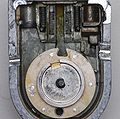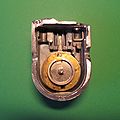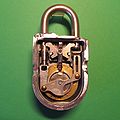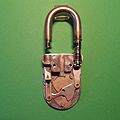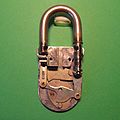S&G 8088
Sargent & Greenleaf 8088
| Sargent & Greenleaf 8088 | |
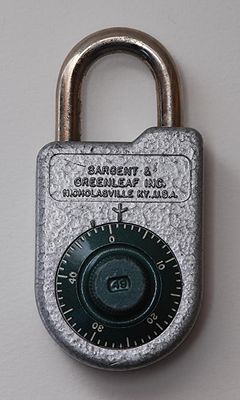 | |
| Name | Sargent & Greenleaf 8088 |
|---|---|
| Manufacturer | Sargent & Greenleaf |
| Lock Type | Padlock |
| Lock Design | Combination |
| Year(s) Produced | 195? - 1985 |
| Patent | US 2,673,457 US 2,625,032 |
| Related Locks | |
| S&G 8065 S&G 8077 | |
The 8088 is a UL 768-rated combination lock made by Sargent & Greenleaf. It is rated for 30 minutes of protection against manipulation and radiological attacks, and 10 minutes of protection against surreptitious attacks. There are no defined protections against destructive entry in the 8088 specifications.
The 8088 was developed in the 1950s for the United States government through one of Sargent & Greenleaf's government contracts.[1] It has since been superceded by the S&G 8077 and the S&G 8065.
Principles of operation
The 8088 is a combination lock that requires three numbers be correctly dialed into the lock for the shackle to be released. It uses three internal wheels and a fence-type mechanism similar to those used in traditional combination safe locks. The dial has fifty graduations numbered 0-49, giving the 8088 a total of 125,000 (503) theoretical permutations.
The 8088 functions very similar to traditional rotary combination safe locks. It uses a set of wheels, a drive cam, a fence, and a mechanism which resembles a butterfly. The butterfly hooks into the shackle, restricting its movement. When the correct combination is dialed the wheels and drive cam are properly aligned under the butterfly. Pulling the shackle causes the butterfly to collapse and pushes the fence into the gates, releasing the shackle.
The opening index mark is location at 12 o'clock on the face of the lock. The changing index, used to reset the combination, is located at 11 o'clock. All combinations are a three number sequence that ends with 0, for example 24-10-40-0 and 42-28-9-0. The last number is required to set the drive cam in the proper position. The factory combination is 25-0 (25-25-25-0), but older models may use 10-20-30-0.
Notes
- The dial of the 8088 may be stamped with a two digit number to prevent casual replacement of the lock.
Opening instructions
These instructions use an example combination of 10-20-30-0
- Dial counter-clockwise four full revolutions, stopping on 10.
- Dial clockwise three full revolutions, stopping on 20.
- Dial counter-clockwise two full revolutions, stopping on 30.
- Dial clockwise to 0.
- Pull the shackle to unlock the padlock.
To dial the factory 25-0 combination (25-25-25-0), all wheels are dialed counter-clockwise four times, stopping at 25. Then dial clockwise, stopping at 0. Pull the shackle to unlock the padlock.
Combination change instructions
- Unlock the lock using the correct combination.
- Hold the change key hole open while returning the shackle to the locked position.
- Dial the original combination, aligning each wheel with the changing index.
- Insert the change key into the change key hole and turn in 90° clockwise.
- Dial the new combination, aligning each wheel with the changing index.
- Turn the change key 90° counter-clockwise and remove it from the lock. Do not close the change key hole!
- Dial the new combination to the opening index and open the lock. Open the lock repeatedly to ensure the new combination works before closing the change key hole.
Notes
- The opening index is at 12 o'clock, the changing index at 11 o'clock.
- Incorrectly dialing any wheel to the opening index and closing the change key hole during step 3 will render the lock non-functional.[2]
Disassembly instructions
The 8088 cannot be disassembled non-destructively. Four retaining rods around the lock body must be drilled to allow the back cover to be removed. Rods are located at 2, 3, 9, and 10 o'clock on the back of the lock. The pins at 3 and 9 o'clock are horizontal while 2 and 10 are vertical.
Vulnerabilities
The 8088 may be vulnerable to one or more of the following:
Notes
- Decoding is possible through both manipulation and radiological attacks.
- Semi-destructive decoding is possible, particularly drilling the lock body and viewing the wheel pack or fence.
Gallery
References
- ↑ Tobias, Marc (1971). Locks, Safes and Security: An International Police Reference. ISBN 0398070792.
- ↑ Sargent & Greenleaf, Inc. 8088 Padlock: Operating Instructions





